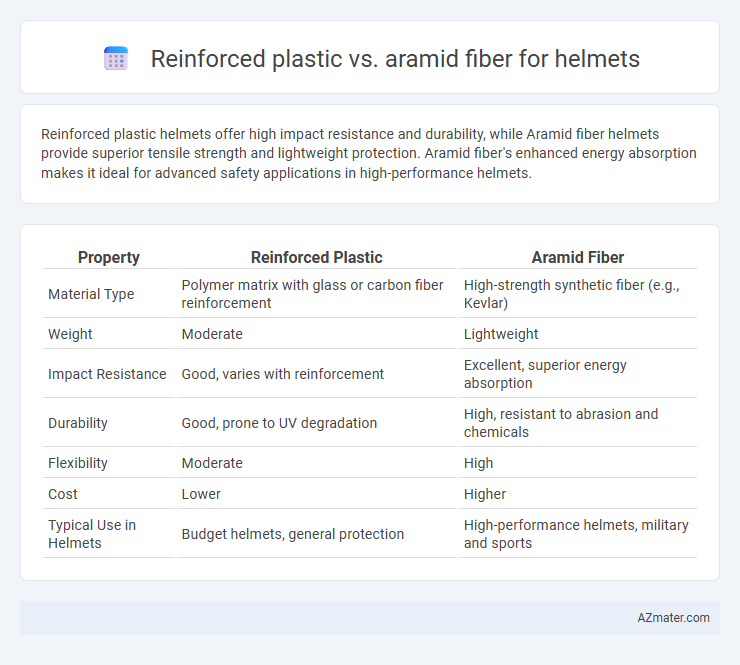Reinforced plastic helmets offer high impact resistance and durability, while Aramid fiber helmets provide superior tensile strength and lightweight protection. Aramid fiber's enhanced energy absorption makes it ideal for advanced safety applications in high-performance helmets.
Table of Comparison
| Property | Reinforced Plastic | Aramid Fiber |
|---|---|---|
| Material Type | Polymer matrix with glass or carbon fiber reinforcement | High-strength synthetic fiber (e.g., Kevlar) |
| Weight | Moderate | Lightweight |
| Impact Resistance | Good, varies with reinforcement | Excellent, superior energy absorption |
| Durability | Good, prone to UV degradation | High, resistant to abrasion and chemicals |
| Flexibility | Moderate | High |
| Cost | Lower | Higher |
| Typical Use in Helmets | Budget helmets, general protection | High-performance helmets, military and sports |
Introduction to Helmet Materials
Reinforced plastic, commonly known as fiberglass or carbon fiber composites, offers high impact resistance and lightweight properties essential for helmet safety. Aramid fibers, such as Kevlar, provide exceptional tensile strength and superior energy absorption, making them ideal for ballistic and motorcycle helmets. Both materials are engineered to enhance durability, comfort, and protection in helmet design by optimizing strength-to-weight ratios and impact performance.
Overview of Reinforced Plastic Helmets
Reinforced plastic helmets combine a polymer matrix with glass or carbon fibers, providing lightweight yet durable protection ideal for impact resistance. These helmets offer enhanced structural integrity, high tensile strength, and excellent resistance to environmental factors such as moisture and UV exposure. The balance of rigidity and flexibility in reinforced plastics makes them a preferred choice for military, sports, and industrial safety applications.
The Science Behind Aramid Fiber Helmets
Aramid fiber helmets leverage the exceptional tensile strength and impact resistance of synthetic fibers like Kevlar, enabling lightweight yet highly protective headgear. The molecular structure of aramid fibers consists of long chains of polyamide molecules linked by hydrogen bonds, providing superior energy absorption and distributing impact forces effectively. Reinforced plastic helmets, while durable, typically lack the same energy dissipation capabilities, making aramid fiber helmets the preferred choice for advanced ballistic and impact protection in safety equipment.
Key Performance Differences
Reinforced plastic helmets provide excellent impact resistance and lightweight properties due to their polymer matrix combined with glass or carbon fibers, making them durable for everyday use. Aramid fiber helmets, utilizing materials such as Kevlar, offer superior tensile strength and higher energy absorption capabilities, enhancing ballistic protection and preventing penetration. The choice between reinforced plastic and aramid fiber depends on required balance between flexibility, weight, and high-level impact or ballistic resistance in helmet applications.
Weight and Comfort Comparison
Reinforced plastic helmets are generally heavier due to denser composite materials, impacting comfort during extended wear by increasing fatigue. Aramid fiber helmets, such as those made with Kevlar, offer superior strength-to-weight ratios, significantly reducing weight for enhanced comfort without compromising protection. The lightweight nature of aramid fiber improves ventilation and reduces pressure points, making it the preferred choice for users prioritizing long-term comfort and mobility.
Impact Resistance and Protection
Reinforced plastic helmets typically offer strong impact resistance due to the integration of glass or carbon fibers, providing reliable protection against blunt force trauma. Aramid fiber helmets, often made with Kevlar, excel in energy absorption and penetration resistance, making them superior for high-velocity impacts and shrapnel defense. The choice between reinforced plastic and aramid fiber for helmets largely depends on the specific threat environment, with aramid fibers favored in ballistic and military applications for enhanced protection.
Durability and Longevity
Reinforced plastic helmets offer excellent durability due to their resistance to impact and environmental degradation, ensuring long-term protection in various conditions. Aramid fiber helmets boast superior tensile strength and resistance to abrasion, providing enhanced longevity by maintaining structural integrity under repeated stress. Both materials deliver reliable performance, but aramid fiber typically outperforms reinforced plastic in maintaining helmet durability over extended use.
Cost Analysis: Reinforced Plastic vs. Aramid Fiber
Reinforced plastic helmets typically offer a lower cost advantage due to cheaper raw materials and simpler manufacturing processes compared to aramid fiber helmets. Aramid fiber helmets, while more expensive upfront, provide superior impact resistance and durability, potentially reducing long-term replacement costs. Cost analysis must balance initial investment with performance benefits, including helmet lifespan and protection level for optimal value.
Industry Standards and Certifications
Reinforced plastic helmets commonly comply with standards such as DOT, ECE 22.05, and Snell, providing proven impact resistance and durability. Aramid fiber helmets exceed these certifications by offering superior tensile strength and energy absorption, meeting rigorous tests like EN 1078 and ASTM F1447. Advanced aramid composites enhance safety compliance, making them preferred in professional and high-performance helmet manufacturing.
Choosing the Right Helmet Material
Reinforced plastic offers a balance of lightweight durability and cost-effectiveness, making it suitable for budget-friendly helmets that still provide reliable impact resistance. Aramid fiber, known for its exceptional tensile strength and heat resistance, delivers superior protection and is ideal for high-performance helmets used in extreme conditions or professional applications. Selecting the right helmet material depends on prioritizing safety standards, weight preferences, and specific usage demands.

Infographic: Reinforced plastic vs Aramid fiber for Helmet
 azmater.com
azmater.com